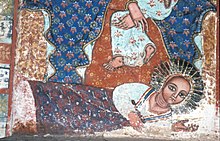Gondarine period
| History of Ethiopia | |
|---|---|
 | |
| 1314–1344 |
Part of a series on the |
||||
|---|---|---|---|---|
| History of Ethiopia | ||||
 | ||||
|
Early history
|
||||
|
Amda Seyon's Expansions | 1314–1344 |
| Oromo migrations | 1543 – 17th cent. |
| Habesh Eyalet | 1557 – 17th cent. |
| Gondarine period | 1632–1769 |
| Zemene Mesafint | 1769–1855 |
| Ottoman border conflict | 1832–1848 |
| Second Italo–Ethiopian War | 1935–1936 |
| Italian East Africa | 1936–1941 |
| World War II | 1941 |
| Italian guerrilla war | 1941–1943 |
| Federation with Eritrea | 1952–1962 |
| Eritrean Independence War | 1961–1991 |
| Ethiopian Civil War | 1974–1991 |
| Ogaden War | 1977–1978 |

The Gondarine period (alt. Gondarian) was a period of Ethiopian history between the ascension of Emperor Fasilides in 1632 and a period of decentralization in 1769, known as the Zemene Mesafint.
The death of
The Gondarine period ended when Tigray governor Ras Mikael Sehul assassinated Iyoas I in 1769 which marked the beginning of the country's decentralized Zemene Mesafint ("Era of Princes") which lasted until Emperor Tewodros II reunified the empire in 1855 in its modern form.

Established in 1636 by Emperor
Fasilides sought to establish diplomatic relations with the Zaydi imam of Yemen Al-Mutawakkil Isma'il from 1642 to 1647, in order to establish trade routes that bypassed Ottoman-held Massawa, but was ultimately unsuccessful.[3] During this period, the Agaw rebellion in Lasta recurred, started by Susenyos.
In 1637, the leader Melka Kristos entered his palace to reclaim his throne, to which Fasilides quickly responded by dispatching Qegnazmach Dimmo, governor of Semien, and his brother Gelawdewos, governor of Begemder. Kristos was eventually defeated at Libo. In the following year, he marched to Lasta, where and retreated to the mountain stronghold there; "almost the whole army perished amidst the mountains, great part from famine, but a greater still from cold,” according to writer James Bruce.[4]
After Emperor Iyasu I’s death in 1706, Gondar began to decay as most Gondarine emperors preferred luxurious city life to spending time in politics.[5][unreliable source?] Empress Regent of Emperor Iyasu I, Mentewab, brought her brother Ras Wolde Leul to Gondar and made him Ras Bitwaded. After Iyasu II’s death in 1755, brief dynastic conflicts occurred between Mentewab's Quaregnoch and Yejju Wollo groups led by Wubit. In 1757, Tigray governor Ras Mikael Sehul occupied Gondar. His wish was to not only become emperor but to consider himself the real leader of the Gondarine period. Emperor Iyoas I was an infant at that time who had no power.[6] In 1769, Ras Mikael Sehul successfully killed Iyoas and crowned 70-year-old Yohannes II, ushering in the decentralized Zemene Mesafint (Era of Princes) era.[citation needed]
Gondarine art drew on the
Scholars classify Gondarine art into two phases: the first used bright colors and an absence of shading, while the second used darker shades of color that developed during the reign of Iyasu II.[citation needed]

Upon the abdication of his father Susenyos, who permitted the Catholic Church in Ethiopia as state religion from 1622, Fasilides sought to expel all Jesuits from Ethiopia and restore the state primacy of Orthodox Tewahedo in his empire. In 1622 Jesuit Afonso Mendes and Jerónimo Lobo, were forcefully expelled under death penalty by Fasilides, to Fremona.[citation needed] During the early 18th century, a few Franciscan and Capuchin friars sponsored by the Roman missionary agency Sacra Congregatio de Propaganda lived there for some years. Among them were Franciscan Giuseppe Maria di Gerusalemme, Remedius Prutky [fr] (who left a valuable report on the city), and the Jesuits Grenier and Paulet.[9]

One of the most iconic works of Gondarine architecture was a royal complex known as Fasil Ghebbi and 44 churches[citation needed] that were built around Lake Tana including Adababay Iyasus, Adababay Tekle Haymanot, Atatami Mikael, Gemjabet Mariyam, Fit Mikael and Qeddus Abbo.[10] Fasilides was also credited with building seven stone bridges including the Sebrara Dildiy bridge over the Blue Nile. Fasilides contributed a new church at the Cathedral of Church of Our Lady Mary of Zion at Axum, named "Old Cathedral" which stands next to the newer cathedral built by Emperor Haile Selassie.[11] According to legend, the Ethiopian Orthodox Tewahedo Church would be constructed by the name of letter "G".[clarification needed] As a result, the Emperor behind Fasilides often built stone castles in Gorgora, Gomange, Guzara and Gannata Iyasus. After becoming aware of the fact, the scenario of urban life in Ethiopia was conceptualized by building more royal camps with replacement of semi-itinerants royal tents to stone and mortar.[12]
The arrival of the Portuguese in the mid-16th century also influenced the architecture style in the Gondarine era, primarily through the building fortress and defense castles. During Roman Catholic state administration under Susenyos, he employed Arab, Gujarati (brought by the Jesuits) and their masonic style with local masons, such as Beta Israel. Turkish architecture also influenced Gondarine architecture through Ottoman incursions, which further increased the prevalence of defense buildings and castles in the area. The style continued to prevail in Fasilides' reign through the Gondarine period and the 17th and 18th century, and went on to influence 19th century design.
Ethiopian philosophers like Zera Yacob, known for his treatise on religion, morality, and reason, known as Hatata and Walda Heywat became prominent at this time.[13]
{{cite book}}: CS1 maint: multiple names: authors list (link)
{{cite book}}: CS1 maint: multiple names: authors list (link)